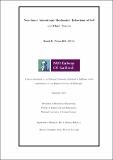| dc.contributor.advisor | McGarry, Patrick | |
| dc.contributor.author | Nolan, David Robert | |
| dc.date.accessioned | 2016-05-09T13:19:28Z | |
| dc.date.issued | 2015-09-30 | |
| dc.identifier.uri | http://hdl.handle.net/10379/5754 | |
| dc.description.abstract | The overall objective of this thesis is to develop accurate and rigorous constitutive formulations for the non-linear anisotropic behaviour of soft tissue (arterial) and hard tissues (trabecular bone) at large strains.
The Holzapfel-Gasser-Ogden (HGO) constitutive model for anisotropic hyperelastic behaviour of collagen fibre reinforced materials was initially developed to describe the elastic properties of arterial tissue, but is now used extensively for modelling a variety of soft biological tissues. A compressible form (HGO-C model) is widely used in finite element (FE) simulations. Here, by using three simple deformations (pure dilatation, pure shear and uniaxial stretch), it is demonstrated that the compressible HGO-C formulation does not correctly model compressible anisotropic material behaviour. In order to correctly model compressible anisotropic behaviour a modified anisotropic (MA) model is presented, whereby the full anisotropic invariants are used, so that volumetric anisotropic contributions are accounted for.
Biaxial tests are commonly used to investigate the mechanical behaviour of soft biological tissues and polymers. In the current paper a fundamental problem associated with the calculation of material stress from measured force in standard biaxial tests is uncovered. In addition to measured forces, localized unmeasured shear forces also occur at the clamps and the inability to quantify such forces has significant implications for the calculation of material stress from simplified force equilibrium relationships. Unmeasured shear forces are shown to arise due to two distinct competing contributions: (1) negative shear force due to stretching of the orthogonal clamp, and (2) positive shear force as a result of material Poisson-effect.
Arterial tissue is commonly assumed to be incompressible. While this assumption is convenient for both experimentalists and theorists, the compressibility of arterial tissue has not been rigorously investigated. The current study presents an experimental-computational methodology to determine the compressibility of aortic tissue and it is demonstrated that specimens excised from an ovine descending aorta are significantly compressible.
The inelastic behaviour of trabecular bone is investigated using both mechanical testing and microstructural FE models. Continuum level constitutive models are used to capture the inelastic mechanical behaviour observed in the above in vitro and in silico tests. | en_IE |
| dc.rights | Attribution-NonCommercial-NoDerivs 3.0 Ireland | |
| dc.rights.uri | https://creativecommons.org/licenses/by-nc-nd/3.0/ie/ | |
| dc.subject | Biomedical engineering | en_IE |
| dc.subject | Constitutive model | en_IE |
| dc.subject | Biomechanics | en_IE |
| dc.subject | Finite element | en_IE |
| dc.subject | Anisotropy | en_IE |
| dc.title | Non-linear anisotropic mechanical behaviour of hard and soft tissues | en_IE |
| dc.type | Thesis | en_IE |
| dc.contributor.funder | Irish Research Council | en_IE |
| dc.contributor.funder | Science Foundation Ireland | en_IE |
| dc.local.note | This thesis investigates the behaviour of hard tissue (bone) and soft tissue (arterial) under mechanical deformation. Biological tissues exhibit a complex, directional dependent response and are subjected to large deformations. Precise experimental studies and theoretical models are developed with the overall goal of improving computational simulations for medical device design. | en_IE |
| dc.description.embargo | 2016-11-09 | |
| dc.local.final | Yes | en_IE |
| nui.item.downloads | 628 | |


